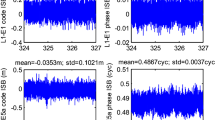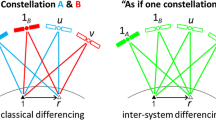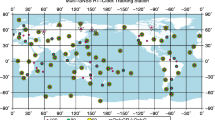Abstract
The intra-system biases, including differential code biases (DCBs) and differential phase biases (DPBs), are generally defined as the receiver-dependent hardware delays between different frequencies in a single global navigation satellite system (GNSS) constellation. Likewise, the inter-system biases (ISBs) are the differential code and phase hardware delays between different GNSSs, which are of great relevance for combined processing of multi-GNSS and multi-frequency observations. Although the two biases are usually assumed to remain unchanged for at least 1 day, they sometimes can exhibit remarkable intraday variability, likely due to environmental factors, particularly the ambient temperature. It has been proved that the possible short-term temporal variations of receiver DCBs and DPBs are directly related to ambient temperature fluctuation. We analyze whether the variability of the biases is sensitive to temperature and further identify how this affects the performance of real-time kinematic (RTK) positioning. Our numerical tests, carried out using GPS, BDS-3, Galileo and QZSS observations collected by zero and short baselines, suggest two major findings. First, we found that while ISBs associated with overlapping frequencies are fairly stable, those associated with non-overlapping frequencies can exhibit remarkable variability over a rather short period of time, driven by the changes of ambient temperature. Second, by pre-calibrating and modeling of the biases for the baselines at hand, the empirical success rates and positioning performance can be significantly improved when compared to classical and inter-system differencing, with both models assuming time-invariant receiver DCBs, DPBs and ISBs.















Similar content being viewed by others
Data availability
The raw data were provided by the GNSS Application and Research Group at the Institute of Geodesy and Geophysics at the Chinese Academy of Sciences in Wuhan. The raw data used during the study are available from the corresponding author by request.
References
Choi K, Yoo W, Kim L, Lee Y, Lee H (2019) A distributed method to estimate RDCB and SDCB using a GPS receiver network. Meas Sci Technol 30(10):105105. https://doi.org/10.1088/1361-6501/ab25c3
Coster A, Williams J, Weatherwax A, Rideout W, Herne D (2013) Accuracy of GPS total electron content: GPS receiver bias temperature dependence. Radio Sci 48(2):190–196. https://doi.org/10.1002/rds.20011
Dalla Torre A, Caporali A (2015) An analysis of intersystem biases for multi-GNSS positioning. GPS Solut 19(2):297–307. https://doi.org/10.1007/s10291-014-0388-2
Deng C, Tang W, Liu J, Shi C (2014) Reliable single-epoch ambiguity resolution for short baselines using combined GPS/BeiDou system. GPS Solut 18(3):375–386. https://doi.org/10.1007/s10291-013-0337-5
Elghazouly A, Doma M, Sedeek A (2019) Estimating satellite and receiver differential code bias using a relative Global Positioning System network. Ann Geophys-Germany 37(6):1039–1047. https://doi.org/10.5194/angeo-37-1039-2019
Gao W, Gao C, Pan S, Meng X, Xia Y (2017) Inter-system differencing between GPS and BDS for medium-baseline RTK positioning. Remote Sensing 9(9):948. https://doi.org/10.3390/rs9090948
Gao W, Meng X, Gao C, Pan S, Wang D (2018) Combined GPS and BDS for single-frequency continuous RTK positioning through real-time estimation of differential inter-system biases. GPS Solut 22(1):20. https://doi.org/10.1007/s10291-017-0687-5
Gioia C, Borio D (2016) A statistical characterization of the Galileo-to-GPS inter-system bias. J Geodesy 90(11):1279–1291. https://doi.org/10.1007/s00190-016-0925-6
Håkansson M, Jensen A, Horemuz M, Hedling G (2017) Review of code and phase biases in multi-GNSS positioning. GPS Solut 21(3):849–860. https://doi.org/10.1007/s10291-016-0572-7
Jiang N, Xu Y, Xu T, Xu G, Sun Z, Schuh H (2017) GPS/BDS short-term ISB modelling and prediction. GPS Solut 21(1):163–175. https://doi.org/10.1007/s10291-015-0513-x
Li M, Yuan Y, Wang N, Liu T, Chen Y (2018) Estimation and analysis of the short-term variations of multi-GNSS receiver differential code biases using global ionosphere maps. J Geodesy 92(8):889–903. https://doi.org/10.1007/s00190-017-1101-3
Li W, Wang G, Mi J, Zhang S (2019) Calibration errors in determining slant Total Electron Content (TEC) from multi-GNSS data. Adv Space Res 63(5):1670–1680. https://doi.org/10.1016/j.asr.2018.11.020
Mi X, Zhang B, Yuan Y (2019a) Multi-GNSS inter-system biases: estimability analysis and impact on RTK positioning. GPS Solut 23(3):81. https://doi.org/10.1007/s10291-019-0873-8
Mi X, Zhang B, Yuan Y (2019b) Stochastic modeling of between-receiver single-differenced ionospheric delays and its application to medium baseline RTK positioning. Meas Sci Technol 30(9):095008. https://doi.org/10.1088/1361-6501/ab11b5
Mi X, Zhang B, Yuan Y, Luo X (2019c) Characteristics of GPS, BDS2, BDS3 and Galileo inter-system biases and their influence on RTK positioning. Meas Sci Technol 31(1):015009. https://doi.org/10.1088/1361-6501/ab4209
Nadarajah N, Khodabandeh A, Wang K, Choudhury M, Teunissen PJG (2018) Multi-GNSS PPP-RTK: from large- to small-scale networks. Sensors 18(4):1078. https://doi.org/10.3390/s18041078
Odijk D, Teunissen PJG (2012) Characterization of between-receiver GPS-Galileo inter-system biases and their effect on mixed ambiguity resolution. GPS Solut 17(4):521–533. https://doi.org/10.1007/s10291-012-0298-0
Odijk D, Nadarajah N, Zaminpardaz S, Teunissen PJG (2017) GPS, Galileo, QZSS and IRNSS differential ISBs: estimation and application. GPS Solut 21(2):439–450. https://doi.org/10.1007/s10291-016-0536-y
Odolinski R, Teunissen PJG (2017) Low-cost, 4-system, precise GNSS positioning: a GPS, Galileo, BDS and QZSS ionosphere-weighted RTK analysis. Meas Sci Technol 28(12):125801. https://doi.org/10.1088/1361-6501/aa92eb
Odolinski R, Teunissen PJG, Odijk D (2014a) Combined BDS, Galileo, QZSS and GPS single-frequency RTK. GPS Solut 19(1):151–163. https://doi.org/10.1007/s10291-014-0376-6
Odolinski R, Teunissen PJG, Odijk D (2014b) First combined COMPASS/BeiDou-2 and GPS positioning results in Australia. Part II: Single- and multiple-frequency single-baseline RTK positioning. J Spatial Sci 59(1):25–46. https://doi.org/10.1080/14498596.2013.866913
Odolinski R, Teunissen PJG, Odijk D (2015) Combined GPS + BDS for short to long baseline RTK positioning. Meas Sci Technol 26(4):045801. https://doi.org/10.1088/0957-0233/26/4/045801
Paziewski J, Wielgosz P (2014) Accounting for Galileo–GPS inter-system biases in precise satellite positioning. J Geodesy 89(1):81–93. https://doi.org/10.1007/s00190-014-0763-3
Paziewski J, Sieradzki R, Wielgosz P, Technology (2015) Selected properties of GPS and Galileo-IOV receiver intersystem biases in multi-GNSS data processing. Meas Sci Technol 26(9):095008. https://doi.org/10.1088/0957-0233/26/9/095008
Su K, Jin S (2019) Triple-frequency carrier phase precise time and frequency transfer models for BDS-3. GPS Solut 23(3):86. https://doi.org/10.1007/s10291-019-0879-2
Teunissen PJG (1995) The least-squares ambiguity decorrelation adjustment: a method for fast GPS integer ambiguity estimation. J Geodesy 70:65–82. https://doi.org/10.1007/bf00863419
Teunissen PJG (2018) Distributional theory for the DIA method. J Geodesy 92(1):59–80. https://doi.org/10.1007/s00190-017-1045-7
Yang Y, Xu Y, Li J, Yang C (2018) Progress and performance evaluation of BeiDou global navigation satellite system: data analysis based on BDS-3 demonstration system. Sci China Earth Sci 61(5):614–624. https://doi.org/10.1007/s11430-017-9186-9
Zha J, Zhang B, Yuan Y, Zhang X, Li M (2019) Use of modified carrier-to-code leveling to analyze temperature dependence of multi-GNSS receiver DCB and to retrieve ionospheric TEC. GPS Solut 23(4):103. https://doi.org/10.1007/s10291-019-0895-2
Zhang B, Teunissen PJG (2015) Characterization of multi-GNSS between-receiver differential code biases using zero and short baselines. Sci Bull 60(21):1840–1849. https://doi.org/10.1007/s11434-015-0911-z
Zhang B, Teunissen PJG, Yuan Y (2016) On the short-term temporal variations of GNSS receiver differential phase biases. J Geodesy 91(5):563–572. https://doi.org/10.1007/s00190-016-0983-9
Zhang B, Liu T, Yuan Y (2017) GPS receiver phase biases estimable in PPP-RTK networks: dynamic characterization and impact analysis. J Geodesy 92(6):659–674. https://doi.org/10.1007/s00190-017-1085-z
Zhang X, Zhang B, Yuan Y, Zha J (2020) Extending multipath hemispherical model to account for time-varying receiver code biases. Adv Space Res 65(1):650–662. https://doi.org/10.1016/j.asr.2019.11.003
Acknowledgements
This work was partially funded by the National Natural Science Foundation of China (Grant No. 41774042), the Scientific Instrument Developing Project of the Chinese Academy of Sciences (Grant No. YJKYYQ20190063), the BDS Industrialization Project (Grant No. GFZX030302030201-2) and the National Key Research Program of China Collaborative Precision Positioning Project (Grant No. 2016YFB0501900). The second author was supported by the CAS Pioneer Hundred Talents Program.
Author information
Authors and Affiliations
Corresponding author
Additional information
Publisher's Note
Springer Nature remains neutral with regard to jurisdictional claims in published maps and institutional affiliations.
Rights and permissions
About this article
Cite this article
Mi, X., Zhang, B., Odolinski, R. et al. On the temperature sensitivity of multi-GNSS intra- and inter-system biases and the impact on RTK positioning. GPS Solut 24, 112 (2020). https://doi.org/10.1007/s10291-020-01027-5
Received:
Accepted:
Published:
DOI: https://doi.org/10.1007/s10291-020-01027-5




